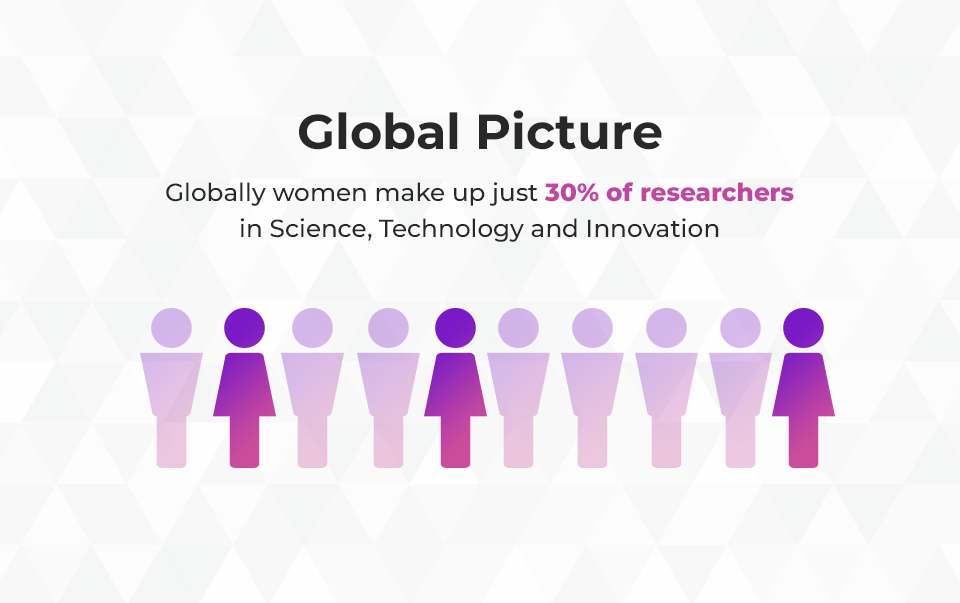A Day in the Life of a Female Data Scientist

There I was—at Nvidia Deep learning & AI, the most prestigious deep learning event, waiting for my hands-on training to begin. It felt great to be there! But as I waited for things to start, observing the others who sat around me, I realized something: most of the attendants were men! In a crowded hall where around 200 people were waiting for a lecture, less than 10% were women. Where were the rest, and why was I one of the few female representatives who attended this conference?
30% of Researchers Are Women
Generally speaking, men dominate the field of data science. This isn’t something I concluded anecdotally after I studied conference attendance statistics at this one event. After all, this is already well known—women make up just about 30% of researchers in science, technology, and innovation. And the percentage is even smaller if we only look at just data science as an area of interest. So why is that?
We’re aware of the fact that women comprise roughly 50% of the world population and can equally contribute to science, technology, engineering, and mathematics (STEM) research fields. And there are many communities that are encouraging women to move into STEM. But despite these efforts, there haven’t been any notable breakthroughs.
I read somewhere that one of the bigger shifts actually occurs when women hit their 30s and begin leaving their jobs because they’re tired of juggling childbearing and personal matters with their career. Having both is rewarding, sure, but it’s also exhausting and difficult to manage. I should know—I deal with it every day!
But I also know for sure that it’s not impossible for women to find work-life balance in order to maintain a career in STEM. Here’s a good quote from Suzanne Cory, former president of the Australian Academy of Science:
‶I don’t think there are barriers to women to have careers in science?—I think it’s up to women to take the challenge. The door is open and they need to walk through it.”
Well, Suzanne, I’ve certainly opened this door that you’re talking about. So I guess I should be honest—it’s pretty crazy inside.
What This Means for Me
What does the day of a female data scientist look like? Well, truth be told, the same as that of a male data scientist! (But maybe a bit more hectic.)
In the following sections, I’ll describe the four basic components that are present in a data scientist’s everyday work from the eyes of a woman in this field.
4 Components of a Data Scientist’s Everyday Work
You’ll encounter these four things throughout your daily work as a data scientist:
- Data (the heart of every project).
- Code (the tools necessary for your work).
- Algorithms (the brain of each project).
- An idea (the thing that initiates it all).
Let’s take a closer look at each one!
1. Data
I don’t remember a day when I didn’t need to open an IDE and type in some sort of query, or extract file data, or visualize a dataset in R or Python. Working with SQL and data wrangling in R and Python are practically in the description of my everyday work.
Data is the foundation of what I do—because without (good) data, there are no data science projects. So, female or male, you have the same job: we all have to be comfortable working with data, no matter where it is and in what form.
We live in the era of data. Taking pictures of my family, making a to-do list on my cell phone, Googling a recipe for a birthday cake, paying bills from the comfort of my home, using a GPS to reach my desired destination… Then, at work, I analyze banking business and all the joy (read: data) that it brings—customers, transactions, payment orders, arrangements.
So yes, I’m a woman, and I like culinary sites. But I also like to use raw data to get some powerful data insights. I’m more than happy to combine both these passions.
Women are by nature good analysts and have a great eye for detail. Those qualities make us especially well suited to filling data science roles.
2. Code
Quite often, I do record my to-do list on a piece of paper or on my cell phone. It’s my ‶home” code that helps me with my life and family matters—with it, I don’t forget to buy milk, go to my kid’s parent-teacher conference, buy a birthday gift for a friend, or call my husband and ask for help
Home code is one thing. Business code is another.
Yes, I also code at work—on a daily basis. And without coding, my life would be empty. Every single day involves some kind of SQL, Python, or R script that’s open and waiting to be executed. It’s simply a must in my line of work.
Coding is the tool that helps me do my job as a data scientist. And what’s interesting is that women are generally very meticulous and organized, so their code looks awesome! If you have good coding habits, it’ll also be well documented, which, as others will tell you, is very important.
True, sometimes women are control freaks But I’d argue that’s great when it comes to coding.
3. Algorithms
Do you ever feel that you live every day according to some algorithm? I sometimes wonder if each day is just one big chain of if-then-else. I get up, prepare breakfast, wake and prepare my kid for kindergarten, drive from home to work, do my work, eat, cook, clean, and sleep. Rinse and repeat.
According to this algorithm, I’m constantly working towards completing some goal, rarely finding time for a break, especially at work. Data analysis. Machine learning. Logistic regression. Random forests. Neural nets. Forecasting desired outcomes. Thousands upon thousands of algorithms are written, and one life is not enough to study them all. Trust me—be smart and learn fast because there is no time to waste
Generally speaking, women are very analytical. This is a great personality that helps us write and use good algorithms.
4. An idea
Yesterday morning, my kid woke me up at 5:30 in the morning. She wanted to play with her toy crocodile and build a house from LEGO blocks. (Spoiler: we did.) And that all happened before my first coffee! Two hours later, after I was sufficiently hyped up on caffeine, I started my creative work.
Yes, indeed, data science does require creativity. You must be creative with extracting data, transforming data, writing code, choosing algorithms, and solving problems. Because no two problems will ever be the same in this field.
If you’re not motivated and want to just work according to a cookbook, you’ll fail. My kid doesn’t want to build the same LEGO castle every day, and my boss doesn’t want the same data story every day. So never lose your passion for playing. Because it’s through games and creative freedom that great ideas (and castles) are born. Women are quite incredibly imaginative sometimes.
Tips for Data Science Success
That about wraps it up for my everyday work. But are these four components alone enough to succeed as a data scientist?
Not really. Here’s the thing: we all need to work on ourselves and be aware of the fact that all STEM fields require lots of devotion and effort—regardless of your gender.
It won’t always be easy. So here are some tips to help you in your everyday work.
Be receptive of criticism
Some women don’t like criticism, even if it’s constructive and well meaning. But knowing how to handle criticism is essential to success in the business world.
I became aware of the power of criticism last year when I delivered a presentation to a large audience. Most of them responded positively and told me everything was great. Only a few people gave some constructive criticism—and I actually learned something from it.
We all like to think we’re perfect, but we aren’t. Criticism can hurt, but it’s necessary if you want to improve yourself.
Ask for help when you need it
Some women also like to refuse help in favor of independence (I know I do, at least). I can do this myself! Sound familiar? If you’re running into problems, you should really ask for help. Because there’s no shame in admitting that you can’t do something on your own—it’s something both men and women face on a daily basis.
After all, being a good data scientist doesn’t mean lone-wolfing everything. That’s not the point of your job. Almost every data science project will require the help of others. This stems from the complexity of business itself—it’s (nearly) impossible for one individual to cover all aspects of a project alone. In data science, this means you’ll often be working in a team of other professionals who are not there to get in your way but rather to help you do what you do best.
Every day, I share my thoughts and ideas with my colleagues. Are you a team player? (If not, you need to be.)
Improve yourself with constant learning
Don’t let your obligations distract you from learning. It’s a must, and you need to find some time for it. This doesn’t necessarily mean that you have to stop cooking or playing with your kids because those activities are time consuming. Rather, it means you should set aside some time in your day to read an article during a break at work, or learn something new while you wait for that piece of code to run, or while the kids are asleep in the evening.
Nowadays, you don’t need to go to college to share (or acquire) knowledge. You also don’t need to spend your lifetime savings to specialize in something like data science. Online data science courses are quickly growing in popularity—online learning platforms give you more flexible learning options so you can balance work, life, and learning.
Know that there will always be ups and downs
Part of being a female professional in STEM is about building character. In my line of work, it’s often necessary to learn how to quickly get up and move on after falling. There’s a lot of research going on in the growing field of data science. You could spend several days or months on work that eventually leads to a dead end. At that point, some women are quite stubborn and don’t give up easily. But, speaking from experience, you need to know when to move on. With every failure, you learn something new. If you make ten attempts and succeed with one of them, you’ve still made progress.
Conclusion
Women may be underrepresented in data science, but that doesn’t mean that this line of work is any different for a woman than it is for a man. When it comes to women, I think the main challenge is how we choose to reconcile our business life with our private one. Managing both isn’t easy, and that’s why many women choose one (often family) over the other. But juggling both spheres of life is definitely doable with some effort—and there’s really never been a better time for women to get into STEM.










